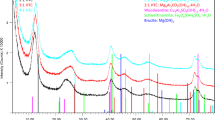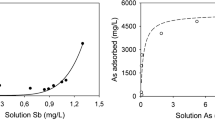Abstract
Process water from the Ranger Uranium Mine requires treatment to meet stringent environmental water quality criteria. The acidic water contains substantial SO4, metals, and U. One novel treatment method under consideration is the use of Na-aluminate to both neutralise the process water and precipitate hydrotalcites. Hydrotalcites are a class of Mg–Al layered double hydroxide minerals with a typical endmember chemical composition: Mg6Al2(A)(OH)16·n(H2O), where A = CO3 2−, SO4 2−, etc. Many acidic wastewaters contain Mg and/or Al in sufficient abundance for hydrotalcite formation upon addition of alkali to achieve solution pH > 5, and Mg and/or Al to attain a Mg:Al ratio of 2 to 3:1. The utility of hydrotalcites lies in their ability to incorporate a range of cationic (Cu2+, UO2 2+), metalloid (AsO4 3−), and (oxy)anionic contaminants (CrO4 2−). The broad spectrum removal of contaminants, including U, also indicates that hydrotalcites and their derivatives could potentially be used as a containment material in nuclear waste repositories. In this study, Ranger process water derived from extraction of U from chloritic schist was treated with Na-aluminate sourced from Bayer process liquor, in combination with NaOH or Ca(OH)2. Hydrotalcites formed as the primary mineral during process water neutralisation with the ability to simultaneously remove a suite of contaminants from solution.





Similar content being viewed by others
References
Allada RK, Navrotsky A, Boerio-Goates J (2002) Thermochemistry of hydrotalcite-like phases in MgO-Al2O3-CO2-H2O system: a determination of enthalpy, entropy and free energy. Am Mineral 90:329–335
Allada RK, Peltier E, Navrotsky A, Casey WH, Johnson A, Berbeco HT, Sparks DL (2006) Calorimetric determination of the enthalpies of formation of hydrotalcite-like solids and their use in the geochemical modelling of metals in natural waters. Clay Clay Miner 54:409–417
American Public Health Association (APHA) (2005) Standard methods for the examination of water and wastewater, 21st edn. The American Public Health Assoc, the American Water Works Assoc, and the Water Environment Federation, Washington, p 1368
Bargar JR, Reitmeyer R, Lenhart JJ, Davis JA (2000) Characterization of U(VI)-carbonato ternary complexes on hematite: EXAFX and electrophoretic mobility measurements. Geochim Cosmochim Acta 64:2737–2749
Behrens M, Kasatkin I, Kuhl S, Weinberg G (2010) Phase-pure Cu,Zn,Al Hydrotalcite-like materials as precursors for copper rich Cu/ZnO/Al2O3 catalysts. Chem Mater 22:386–397
Cavani F, Trifiro F, Vaccari A (1991) HT-type anionic clays: preparation, properties and applications. Catal Today 11:173–301
Depege C, El Metoui FZ, Forano C, de Roy A, Dupuis J, Besse JP (1996) Polymerization of silicates in layered double hydroxides. Chem Mater 8:952–960
Douglas GB (2004) Remediation of groundwater. Provisional Patent Application
Douglas GB (2009) Treatment and remediation of natural and wastewater. Provisional Patent Application
Douglas G, Pleysier R, Wendling L (2009) Mineralogical and SEM analysis of ranger process water precipitates. CSIRO Minerals Report DMR 3571, p 27
Feder F, Trolard F, Klingelhofer G, Bourrie G (2005) In situ Mossbauer spectroscopy: evidence for green rust (fougerite) in a gleysol and its mineralogical transformations with time and depth. Geochim Cosmochim Acta 69:4463–4483
Genin J-MR, Refait P, Bourrie G, Abdelmoula M, Trolard F (2001) Structure and stability of the Fe(II)-Fe(III) green rust “fougerite” mineral and its potential for reducing pollutants in soil solutions. Appl Geochem 16:559–570
Gu B, Brooks SC, Roh Y, Jardine PM (2003) Geochemical reactions and dynamics during titration of a contaminated groundwater with high uranium, aluminium and calcium. Geochim Cosmochim Acta 6:2749–2761
Kameda T, Yabuuchi F, Yoshioka T, Uchida M, Okuwaki A (2003) New method of treating dilute mineral acids using magnesium-aluminium oxide. Water Res 37:1545–1550
Koilraj P, Kannan S (2010) Phosphate uptake behaviour of ZnAlZr ternary layered double hydroxides through surface precipitation. J Coll Inter Sci 341:289–297
Ludwig KR, Grauch RI, Nutt CJ, Nash JT, Frishman D, Simmons KR (1987) Age of uranium mineralisation at the Jabiluka and Ranger deposits, Northern Territory, Australia: new U-Pb isotopic evidence. Econ Geol 82:857–874
Miyata S (1983) Anion-exchange properties of HT-like compounds. Clay Clay Miner 31:305–311
Obalova L, Fila V (2005) Kinetic analysis of N2O decomposition over calcined hydrotalcites. Appl Catal B Environ 70:353–359
Parkhurst DL (1995) User’s guide to PHREEQC—a computer program for speciation, reaction-path, advective transport, and inverse geochemical calculations. USGS WRI Report 95-4227, Washington, p 143
Pleysier R, Douglas G, Trefry M, Wendling L, Benn F, Grabsch A, Klauber C (2008) Characterisation of water treatment sludge for ranger (EWLS). CSIRO Minerals Report DMR 3531, p 72
Pleysier R, Douglas G, Trefry M, Wendling L, Benn F, Grabsch A, Klauber C (2009) Characterisation of water treatment sludge. In: Proceedings of an International Mine Water Conference, Pretoria, South Africa, pp 631–638
Scheidegger AM, Strawn DG, Lamble GM, Sparks DL (1998) The kinetics of mixed Ni-Al hydroxide formation of clay and aluminium oxide minerals: a time resolved XAFS study. Geochim CosmochimActa 62:2233–2245
Seida Y, Nakano Y (2000) Removal of humic substances by layered double hydroxide containing iron. Water Res 34:1487–1494
Seida Y, Nakano Y (2002) Removal of phosphate by layered double hydroxides containing iron. Water Res 36:1306–1312
Shin HS, Kim MJ, Nam SY, Moon H-C (1996) Phosphorus removal by HT compounds (HTLcs). Water Sci Technol 34:161–168
Taylor RM (1984) The rapid formation of crystalline double hydroxy salts and other compounds by controlled hydrolysis. Clay Miner 19:591–603
Thompson HA, Parks GA, Brown GE (1999) Dynamic interactions of dissolution, surface adsorption, and precipitation in an aging cobalt(II)-clay-water system. Geochim Cosmochim Acta 63:1767–1779
Ulibarri MA, Pavlovic I, Barriga C, Hermosín MC, Cornejo J (2001) Adsorption of anionic species on hydrotalcite-like compounds: effect of interlayer anion and crystallinity. Appl Clay Sci 18:17–27
Vucelic M, Jones W, Moggridge GD (1997) Cation ordering in synthetic layered double hydroxides. Clays and Clay Miner 45:803–813
Acknowledgments
CSIRO wishes to acknowledge the assistance of Dr Tony Milnes, General Manager, Environmental Strategy, Energy Resources of Australia Ltd, and his staff for their support and assistance in undertaking this project.
Author information
Authors and Affiliations
Corresponding author
Rights and permissions
About this article
Cite this article
Douglas, G.B., Wendling, L.A., Pleysier, R. et al. Hydrotalcite Formation for Contaminant Removal from Ranger Mine Process Water. Mine Water Environ 29, 108–115 (2010). https://doi.org/10.1007/s10230-010-0106-4
Received:
Accepted:
Published:
Issue Date:
DOI: https://doi.org/10.1007/s10230-010-0106-4




